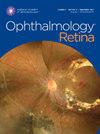Guidelines for the Diagnosis, Management, and Study of Autoimmune Retinopathy from the American Academy of Ophthalmology's Task Force
IF 5.7
Q1 OPHTHALMOLOGY
引用次数: 0
Abstract
Purpose
The American Academy of Ophthalmology created a Task Force to advance the understanding of autoimmune retinopathy (AIR) and provided guidelines on the diagnosis and management of this complex disorder.
Design
A search on PubMed and Google Scholar of English-language studies was conducted without date restrictions. The Task Force reviewed the current literature and formulated an expert consensus on the management of AIR as well as recommendations for future efforts to improve our understanding of this condition.
Results
Key clinical and imaging features are discussed, and a new diagnostic framework is proposed based on the likelihood of AIR (probable AIR, possible AIR, and unlikely AIR) to provide a more standardized approach for categorizing disease. Patients who possess all the following features can be categorized as having probable AIR: (1) signs of disease progression based on subjective symptoms and objective testing within 6 months; (2) examination with <1+ anterior chamber cells, vitreous cells, or vitreous haze; (3) OCT with outer retinal disruption and loss of the external limiting membrane/outer retinal bands/ellipsoid zone often relatively sparing the fovea; (4) characteristic fundus autofluorescence abnormalities; (5) full-field electroretinogram (ERG) with reduction of both rod and cone responses; and (6) positive antiretinal antibodies. Those with some but not all of these features, or with otherwise atypical presentations, can be classified as possible AIR. Features that would make AIR unlikely and should elicit strong suspicion for alternative diagnoses are as follows: (1) slowly progressive symptoms or changes on testing taking place over the years; (2) retinal examination with bone spicules, retinal vascular sheathing, or retinal hemorrhages; (3) examination with >1+ anterior chamber cells, vitreous cells, or vitreous haze; (4) OCT changes predominantly at the level of the retinal pigment epithelium (RPE) or areas of focal/sharply delineated outer retinal/RPE atrophy; (5) fluorescein angiography with diffuse retinal vasculitis or large areas of nonperfusion; or (6) a normal full-field ERG (even with an abnormal multifocal ERG).
Conclusions
These criteria will allow for better classification of patients reported in the literature and improve communication between clinicians. Further study is necessary to optimize the approach for managing AIR and will require collaborative multicenter efforts.
Financial Disclosure(s)
Proprietary or commercial disclosure may be found in the Footnotes and Disclosures at the end of this article.
美国眼科学会工作组的自身免疫性视网膜病变诊断、管理和研究指南。
目的:美国眼科学会成立了一个特别工作组,以促进对自身免疫性视网膜病变(AIR)的了解,并为这一复杂疾病的诊断和管理提供指南:设计:在 PubMed 和 Google Scholar 上对英文研究进行搜索,没有日期限制。专责小组回顾了当前的文献,并就 AIR 的管理达成了专家共识,同时还提出了未来工作建议,以提高我们对这一疾病的认识:结果:讨论了关键的临床和影像学特征,并根据 AIR 的可能性(可能 AIR、可能 AIR 和不可能 AIR)提出了一个新的诊断框架,为疾病分类提供了一种更标准化的方法。具备以下所有特征的患者可被归类为可能患有 AIR:(1) 根据主观症状和 6 个月内的客观检查,有疾病进展的迹象;(2) 检查发现前房或玻璃体细胞/混浊少于 1+、(3)光学相干断层扫描(OCT)显示视网膜外层破坏和外缘膜/视网膜外带/椭圆形区缺失,通常相对不影响眼窝;(4)特征性眼底自动荧光(FAF)异常;(5)全视野 ERG 显示视杆和视锥反应减弱;以及(6)抗视网膜抗体阳性。具有部分但非全部这些特征的患者,或具有其他非典型表现的患者,可被归类为可能的 AIR。AIR 不可能有以下特征,应强烈怀疑其他诊断:(1) 多年来缓慢进展的症状或检查变化;(2) 视网膜检查发现骨刺、视网膜血管鞘或视网膜出血;(3) 检查发现超过 1+ 个前房或玻璃体细胞/混浊、(5) 荧光素血管造影显示弥漫性视网膜血管炎或大面积无灌注;或 (6) 全视野视网膜电图正常(即使多灶视网膜电图异常)。结论:这些标准将有助于对文献报道的患者进行更好的分类,并改善临床医生之间的交流。要优化管理 AIR 的方法,还需要进一步的研究,并需要多中心的共同努力。
本文章由计算机程序翻译,如有差异,请以英文原文为准。
求助全文
约1分钟内获得全文
求助全文

 求助内容:
求助内容: 应助结果提醒方式:
应助结果提醒方式:


